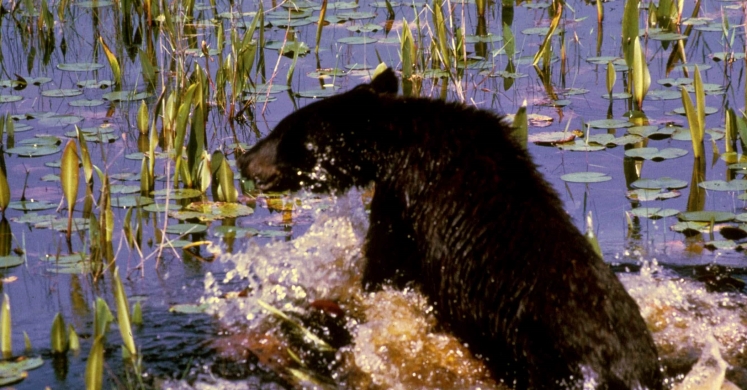Blog

#bioPGH Blog: Keeping Cool!
 A resource of Biophilia: Pittsburgh, #bioPGH is a weekly blog and social media series that aims to encourage both children and adults to reconnect with nature and enjoy what each of our distinctive seasons has to offer.
A resource of Biophilia: Pittsburgh, #bioPGH is a weekly blog and social media series that aims to encourage both children and adults to reconnect with nature and enjoy what each of our distinctive seasons has to offer.
When the summer temperatures soar, we humans aren’t the only ones who feel the heat. Unlike us, though, animals and plants can’t retreat to air conditioning and pour an ice cold glass of lemonade, but nature is resourceful! From hormones to hiding spots to waxy cuticles, the living things of our world have their own ways of managing the sweltering days of summer. Let’s explore!
Birds and mammals are two endothermic groups of animals. “Endothermic” refers to being “warm-blooded,” in other words, being able to maintain their body temperature to a certain extent through physiological mechanisms. Once the external temperature is too warm, though, birds and mammals have to manage the heat in more creative ways, and one of their most common strategies is similar to our own during the hottest part of the day: hide away from the sun. You’ve probably already noticed that many species of birds tend to be the most active and vocal in the morning and evening hours when the heat is less intense, and they’ll stay in the shade as much as possible during the warmest part of the day. Also, both birds and mammals can pant to release excess heat, and quite a few animals will take a quick dip in the water!
These two groups have a few heat management strategies that are specific to their classes, though. Some birds, for example, utilize a…unique…practice of defecating down their legs to help cool themselves off (vultures are a classic example of this). Mammals also have a few extra heat management strategies. Particularly in warmer climates, many mammals such as elephants and foxes have areas of high surface area, like large ears, for example, specifically to release heat and cool off blood as it circulates. In addition, many mammals have biannual molts — a thinner summer coat and a thicker winter coat. The molts are controlled by hormones, and the cues for those hormones are generally based on either photoperiod (day length) or a combination of photoperiod and temperature. I should note, though, that although other mammals can perspire to some degree, humans and horses are really the only mammals that can sweat profusely to manage heat.
Amphibians and reptiles, on the other hand are ectotherms — meaning their body temperatures are largely maintained by their surroundings, rather than through internal physiological processes. Collectively called “herps,” amphibians and reptiles have rather a short list of strategies for beating extreme heat: hide in the shade. Actually even when it feels a bit too warm to us, in Pennsylvania you are likely to see turtles or snakes out basking in the sun purposely to warm up. Once they are warm enough, some herps may duck into a burrow or under leaves to find shade, while others may drop in the water.
Many insects fall into a similar thermoregulation category as herps and rely on their surroundings to help maintain body temperature (though for some species, actions such as flight produce heat). In their case, warming up or cooling down can be as simple as finding shade or sun, or turning the body towards or away from sun. Some insects in extreme habitats, such as the silver ants of the Sahara Desert, even have adaptations such as tiny reflective body hairs to avoid heat.
For plants, well, we know that some of the most productive habitats in the world (rainforests) are often very warm. However, for plants outside of regions where rain is daily occurrence, one of the biggest concerns associated with intense heat is water loss (dessication), and plants have adapted a variety of ways to handle this. One prominent adaptation is the outside layer of leaves, called the “cuticle.” It’s a waxy layer that minimizes water loss due to evaporation. Of course, when plants undergo photosynthesis, they need to undergo gas exchange; thus, leaves have tiny openings in the cuticle called stomata on the underside of the leaves that can open or close as needed. Plants in consistently warm, dry climates generally have long, extended root networks to find as much water as possible; and their leaves tend to be smaller but thicker to store and protect their water.
Well, if all of this talk of heat hasn’t inspired you to find a nice shady tree, you might be a desert dweller. Enjoy the summer sun, and stay cool!
Connecting to the Outdoors Tip: If you’re going on hikes or walks in the summer, be sure to stay hydrated! Bring a (reusable) bottle of water with you, and listen to your body.
Resources
Beltran et al. 2018—Convergence of biannual moulting strategies across birds and mammals.
National Park Service: Reptiles and Amphibians - Introduction, Distribution, and Life History
National Wildlife Federation: How Do Birds Stay Cool in the Summer?
Science: Silver hairs keep desert ants cool
Photo Credits: Pixnio CC0 and Pexels CC0

